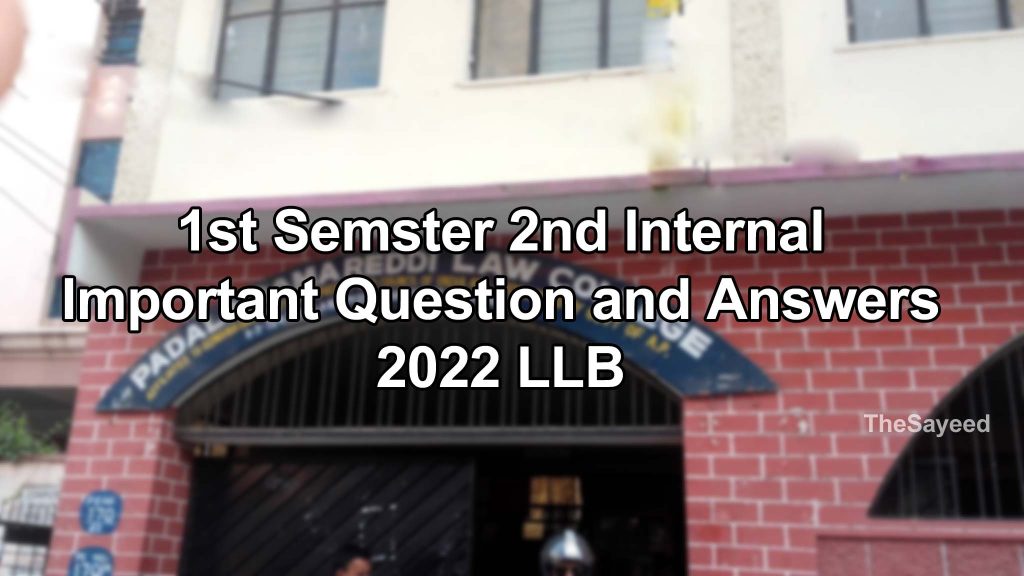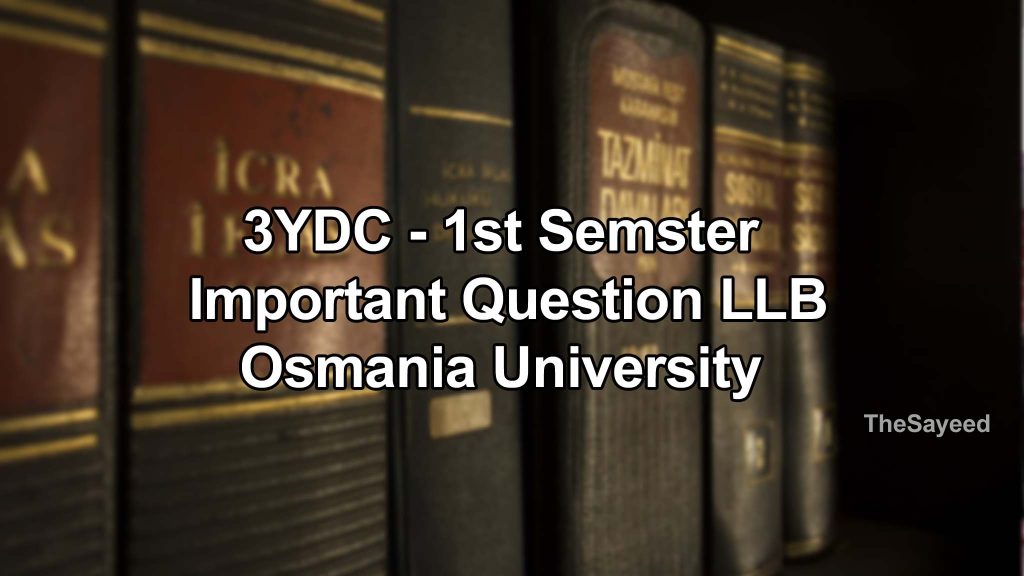Internal Questions Law of Crimes, Evidance
Law of Crimes
- Sec 510 – the section which deals with misconduct in public by drunken people in ipc
- a person committing criminal intimidation if he threatens another – All (person, reputation, or property)
- selling goods marked with counterfeit is deal in section – 486
- Criminal whoever enters into or upon Property of another with intent has committed criminal trespass
- in which year 498a to punish cruelty by husband – 1983
- A finds a purse with money, not knowing to whom it belongs; he afterwards discovers that it belongs to Z, and appropriates it to his own use. Criminal Misappropriation
- Whoever by words either spoken or intended to be read or by signs and visual representations makes or publishes Defamation
- Cohabitation caused by a man deceitfully inducing a belief of lawful marriage. – Sec 493
- Abetting the Commission of suicide – 306
- A voluntarily throws into a river a ring belonging to Z, with the intention of thereby causing wrongful loss to Z. A has committed mischief.
- Section 304 A deals with death by negligence
- habitually dealing in stolen property is dealt with sec 413
497 of ipc deals with adultery
- punishment for defamation is simple imprisonment extend to two years, or with fine, or with both
- Intentionally insults, and thereby gives provocation – Sec 504
- Wrongful restraint means preventing a person from proceeding in any direction
- Sec 498 – Enticing or taking away or detaining with criminal intent a married woman.
- a person signs his own name to a bill of exchange, intending that it may be believed that the bill was drawn by another person of the same name. forgery
- A commits house-trespass by entering Z’s house through a window. – house-breaking.
- marrying again during lifespan of spouse bigamy
- Distinguish between culpable and non-culpable homicide
| Culpable Homicide | Non-Culpable Homicide | |
| Definition | Causing death with culpability | Causing death without culpability |
| Intent | Intention or knowledge of likelihood of death | No intent or knowledge of likelihood of death |
| Classification | Murder, Manslaughter | Self-defense, Lawful duty |
| Liability | Criminal liability established based on level of culpability | No criminal liability, justified force |
| Examples | Deliberate killings, manslaughter | Self-defense, actions in lawful duty |
- Define kidnapping and abduction: Kidnapping: Kidnapping is the act of unlawfully taking or detaining a person against their will with the intention to demand ransom, harm them, subject them to slavery, or other unlawful purposes. It involves the forced removal or confinement of a person without their consent.
Abduction: Abduction refers to the act of compelling or persuading a person, by deceitful means or force, to go from one place to another. It involves taking a person away against their will, but unlike kidnapping, it may not necessarily involve the intention to demand ransom or harm the individual.
- Explain hurt and grievous hurt
Hurt: Hurt refers to the infliction of any bodily pain, injury, or physical harm upon a person. It includes any injury that is not classified as “grievous hurt” under the IPC. The severity of hurt can range from minor injuries to more significant harm, but it does not encompass the most severe forms of bodily harm.
Grievous Hurt: Grievous hurt is a more severe category of bodily harm that involves injuries that are likely to endanger life, cause permanent disfigurement, or result in impairment or loss of a body part or organ. Grievous hurt includes injuries that are more serious in nature compared to ordinary hurt and may have lasting consequences on the victim’s physical well-being.
- Forgery:
– Forgery is creating or altering a false document with the intent to deceive or defraud.
– Section 463 of the IPC defines forgery as making or altering a false document with the intention to cause harm.
– Section 465 provides punishment of up to two years’ imprisonment, or a fine, or both for forgery.
– Section 467 imposes higher punishment of up to seven years’ imprisonment, along with a fine, for forgery of valuable security, will, or authority.
– Section 468 stipulates punishment of up to seven years’ imprisonment, along with a fine, for forgery committed with the intention to cheat someone.
– Forgery involves deception, dishonesty, and fraudulent activities. Consult a legal professional for jurisdiction-specific guidance.
- Theft and Extortion:
Theft
Theft is the act of dishonestly taking someone else’s movable property without their consent and with the intention to permanently deprive them of it.
It involves unlawfully appropriating or removing property that belongs to another person without their permission.
The Indian Penal Code (IPC) covers theft under Section 378.
Theft is a criminal offense and carries penalties, including imprisonment and fines.
Extortion:
Extortion is the act of obtaining money, property, or any valuable thing from another person by using threats, coercion, or intimidation.
It involves compelling someone to give up their property or engage in an action against their will, through fear or force.
The IPC addresses extortion under Section 383.
Extortion is a serious offense, and those found guilty can face imprisonment and other legal consequences.
Law of Evidence
- Law of evidence applicable to all legal & judicial proceedings.
- In criminal cases, character is always in relevant.
- Judgements defined by the court in relation to matrimonial matters are judgments in domestic relations law.
- Silence amounts to admission Yes
- According to section 25, confessions to police are not admissible as evidence.
- Evidence by dumb witness is possible given through non-verbal means.
- Patent ambiguity refers to uncertainty on the face of a legal document.
- photostat copy of a document is not admissible as secondary evidence
- Presumption is an inference drawn by the court.
- Confession statement recorded by a magistrate is an admissible document.
- Not heard for 7 years, presumed dead.
- In criminal cases, the burden of proof lies on the prosecution.
- Burden of proof is the obligation to prove the fact.
- Cross-examination is the examination of a witness by the opposite party.
- Secondary evidence means evidence other than the original document.(XEROX)
- Facts admitted need not be proved
- Accomplice is a co-partner in crime.
- Estoppel is a rule by which a person is not allowed to deny later on.
- Leading question contains the answer in it.
- Hostile witness is a witness who gives evidence against the party calling them.
Shorts
- Estoppel and kinds of estoppel:
– Estoppel: A legal principle that prevents a person from denying or contradicting their previous statements or actions if it would be unfair or unjust to do so.
– Kinds of estoppel: There are various types of estoppel, including estoppel by record, estoppel by deed, estoppel by conduct, and estoppel by representation.
- Dying declaration:
A statement made by a person who believes they are facing imminent death, regarding the cause or circumstances of their impending death. It is admissible as evidence in certain situations, typically in cases of homicide or suspicious deaths.
- Competency of witness:
Refers to the legal capacity of a person to testify as a witness in court. Generally, any person who is mentally competent and understands the obligation to speak the truth can be a competent witness, subject to certain exceptions and disqualifications.
- Facts that need not be proved:
– Facts that need not be proved: There are certain facts that the law presumes to be true without requiring specific proof. These include facts of common knowledge, facts within the court’s judicial notice, and facts admitted by the parties.
- Burden of proof:
– Burden of proof: The obligation placed on a party in a legal proceeding to establish the truth or validity of a claim or defense. The burden of proof typically lies with the party asserting a positive claim or seeking to prove an issue, and the standard of proof may vary depending on the nature of the case.




Responses